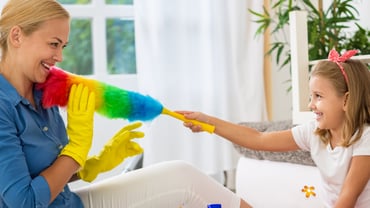Effective speech-language therapy always involves a certain amount of creativity, but pediatric speech-language therapy needs to be filled with creativity, because children learn best through play. Children are curious, so they will explore and experiment with everything in their environment that they can get their hands on – which any parent can tell you!
Here are some ways I like to bring creativity into therapy with my young clients:
- Be Crafty: I find that arts and crafts are a great way to engage children in therapy. A great activity is paper plate crafts—there are so many great ideas out there, and the children really get to have fun with it. I have also made potholders, painted sun catchers or pinecones, and even made bouncy balls in therapy.
- Look for new ways to target goals: For example, my newest activity to help a child with listening comprehension is a scavenger hunt, and I’ve also made cookies (both in therapy and as practice at home). I also enjoy using music in therapy whenever possible, and blowing bubbles, and reading stories.
- Play games: Games generally require taking turns, which is a very important skill that many children need help learning. There are also tons of great games that require expressive verbal skills or listening skills.
- Follow the child’s lead: I learn the things that interest each of the children I work with, so that each is motivated to be involved in his or her own therapy. If he likes dinosaurs, we dig up dinosaurs on my iPad. If she likes puzzles, we take turns putting puzzles together.
- If at first you don’t succeed, try, try again: I make an effort to figure out what works for each child, to help him or her learn the skills we’re working on. For instance, with one child, I tried clapping to emphasize each word in a sentence, but he wasn’t getting it. So we got up and stomped for each word—and that worked!
- Be flexible: If I’m looking for a particular answer, but the child gives a different one that still fits, I accept that answer and praise him for it.
- Let the child do it: Even though it is tempting to show the child the “right way,” he won’t learn if he only watches me do it, and can’t try it himself. So I make myself sit back and let him do it himself. It may not be perfect, and it may take longer, but it’s really important to let him learn by doing.
- Be silly! I try to just relax and have fun, and let the children I treat have fun too—because I know they’re learning at the same time! And because they’re enjoying themselves, they’ll want to come to therapy in the future.
For some ideas to get you started, check out the following sites:
ActivityVillage.co.uk
AFancifulTwist.TypePad.com
LivingIthaca.com
The36thAvenue.com
Sources: NAEYC.org | ED.gov | PlayCoach
Creativity in Pediatric Speech-Language Therapy
Teresa Davis, MS, CCC-SLP
Teresa Davis is a licensed speech-language pathologist who is passionate about helping children of all ages to communicate and has been with Carolina Pediatric Therapy since March of 2014. She received her Masters in Communication Sciences and Disorders from Western Carolina University.



